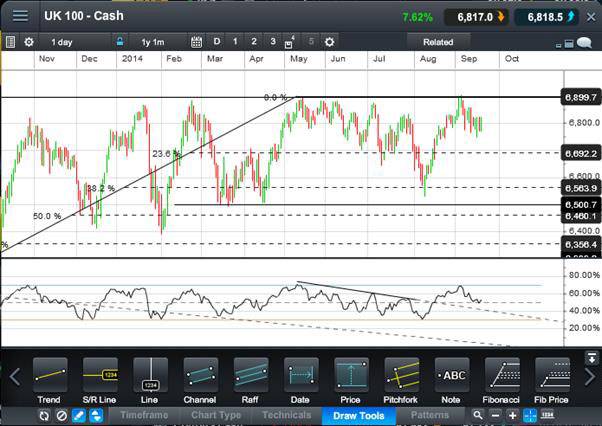Colin Cieszynski is senior market analyst at CMC Markets. He holds both the Chartered Financial Analyst and Chartered Market technician designations.
The Scottish referendum on independence has finally arrived and markets are already active heading into the results.
As has been the case for much of the last two weeks since traders realized how close the race is, more of the action has been in GBP than the FTSE. FTSE hasn't fallen much lately and hasn't rebounded today much either, climbing less than peers like the Dax today.
GBP, meanwhile, is rallying which suggests that traders are starting to anticipate a narrow win by the no side with recent polls running 52-to 53-per cent No. Should this come to fruition, we could see GBP continue to rally while the reaction in FTSE may be smaller is it never really priced in any risk for a Yes vote holding just below its 52-week high.
A surprise win by the Yes side could really upset the apple cart with the FTSE and its Scottish bank components particularly vulnerable. A Yes win could also drive down GBP even further and potentially spark action in Brent Crude and gold.
The results are expected to be spread over several hours so we could see quite a number of swings back and forth as traders scramble to stay on side.
The results are expected to be released in the middle of the night local time but early birds should be able to act on the later results from the larger cities. Australia and New Zealand traders are best positioned to act on the news, which should come out over the course of the Asia Pacific business day. North American traders are also well placed for trading the results, particularly on the west coast where the announcements should come out over the course of the afternoon and evening.
Here's the timing of news related to the results:
Since peaking back in July, GBP has been falling against USD -- losing more than 10 cents from top to bottom. Orderly summer declines on the USD rally accelerated in September as traders realized the risk of a Yes vote had increased significantly.
By last week, RSI had become extremely oversold and a trading rebound has been underway on anticipation of a No win, even if a narrow one. This week, RSI has moved back above 30 and has been quickly rising toward 50, indicating selling pressure easing.
GBP has blasted through $1.6335 (a Fibonacci level) and is testing $1.6400 with next potential resistance close to $1.6500. On a reversal, initial support tests may appear near $1.6335 then $1.6245 near the 10-day moving average or $1.6155, a previous low.
For the last six months, the FTSE has been trading back and forth in a channel between 6,500 and 6,900. Earlier this month, a failure to break out completed a double top and since then the index has been drifting back. It hasn't gone down very far though, remaining near 6,800 in the upper half of this range with RSI holding 50 to confirm underlying interest.
Since it hasn't dropped much lately, it may not rally much on a No win with initial resistance near 6,820 then 6,900 still in place. A Yes vote could pull the rug out from under the index opening a potential test of 6,700 or even 6,500.


